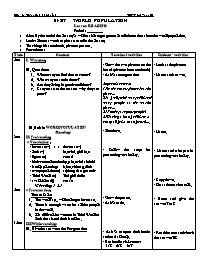Bài soạn môn học Tiếng Anh 11 - Unit 7: World population - Lesson: Reading

· Aim: By the end of the lesson, Ss will be able to get general and information about the world population.
· Lexical items : words or phrases used in the lesson.
· Teaching aids : textbook, pictures, posters.
· Procedures:
Bạn đang xem tài liệu "Bài soạn môn học Tiếng Anh 11 - Unit 7: World population - Lesson: Reading", để tải tài liệu gốc về máy bạn click vào nút DOWNLOAD ở trên
UNIT 7 WORLD POPULATION Lesson : READING Period : ________ Aim: By the end of the lesson, Ss will be able to get general and information about the world population. Lexical items : words or phrases used in the lesson. Teaching aids : textbook, pictures, posters. Procedures: Time Content Teacher’s activities Students’ activities 5ms 8ms 5ms 15ms 10ms 2ms I. Warm up: @. Questions: Where can you find these scenes? What can you see in them? Are they living in good conditions? Can you state the reasons why they are poor? @. Unit 3: WORLD POPULATION (Reading) II. Pre-reading: + Vocabulary : - increase (v) > < decrease (v) - limit (v) hạn chế, giới hạn - figure (n) con số - birth-control method: p.p hạn chế sinh đẻ - family planning: k.hoạch hóa g.đình - overpopulation (n) sự đông dân quá mức - Third World (n) Thế giới thứ ba - available (adj) có sẳn * Checking : R & R + Pre-question: True or False: The world’s p_ will no longer increase. There is enough water for all the people in the world. It is difficult for women in Third World to limit the size of their families. III. While-reading: @. Give the answer to the Pre-question @. Answer the following questions What was the population of the world in 10,000 BC., 1750, 1850, .? How many people is the world expected to have by the year 2015? Can the Earth have enough resources to support its population? Do most Third World women want to have a lot of children? Why can’t women in the world limit the size of their families? IV. Post-reading : A. Discussion: Find out 5 world largest countries in population. Where are they? Which is the richest / poorest country? B. Fill each blank with a suitable word from the box (Task 1) limit, figures, method, although, control, increase, international, resources 1. ______ most journalists studied journalism in college, some older writers never attended a university. 2. Can you explain the _____ for changing salt water to fresh water? 3. The number of injuries from automobile accidents ______ every year. 4. Some countries are poor because they have very few ______. V. Homework: Do at home: Task 1 (cont.) Prepare the next part of the lesson. - Show the two pictures on the board (pictures from textbook) - Ask Ss some questions Expected answers: 1/ In the country/ town/ market place, 2/ a family with many children/ many people at the market place, 3/ No (they are poor people) 3/ Having a lot of children -> not qualified -> out of work, . - Introduce. - Follow the steps for presenting vocabulary. - Show the poster. - Ask Ss to do. - Ask Ss to open their books and read silently. - Get feedback & correct 1/ F 2/ F 3/ T - Ask Ss to answer the questions. -Get feedback & correct: Expected answers : 1. (the figures in textbook) 2. 7 billion. 3. Some scientists say it can, others say it can’t. 4. no, they don’t. 5.because they know of no safe way to have fewer children. - Ask Ss to work in pairs - Give assignment instruct Ss to do the first 4 sentences. - correct: 1/ although 2/ method 3/ increase 4/ resources - Ask Ss to do the rest at home (sentences: 4,5,6,7,8 page: 82) - Look at the pictures - Listen and answer. - Listen. - Listen and take part in presenting vocabulary. - Copy down. - Do as the teacher tells. - Guess and give the answer T or F - Read the text and check the answer T/F - Work in pairs to five the answers. - Copy down. - Work in pairs and give the answer - Look at the text book and do (pair work) - Copy - Listen.
Tài liệu đính kèm:
 11-UNIT 7 Reading.doc
11-UNIT 7 Reading.doc





